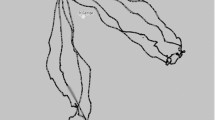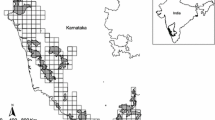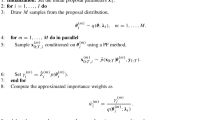Abstract
Estimating temporal variance in animal demographic parameters is of particular importance in population biology. We implement the Schall’s algorithm for incorporating temporal random effects in survival models using recovery data. Our frequentist approach is based on a formulation of band-recovery models with random effects as generalized linear mixed models and a linearization of the link function conditional on the random effects. A simulation study shows that our procedure provides unbiased and precise estimates. The method is then implemented on two case studies using recovery data on fish and birds.




Similar content being viewed by others
References
Barry SC, Brooks SP, Catchpole EA, Morgan BJT (2003) The analysis of ring-recovery data using random effects. Biometrics 59:54–65
Brownie C, Anderson DR, Burnham KP, Robson DS (1985) Statistical inference from band recovery data: a handbook, Second edition. U.S. Fish and Wildlife Service, Resource Publication No. 156. 305 pp
Burnham K, White G (2002) Evaluation of some random effects methodology applicable to bird ringing data. J Appl Stat 29:245–264
Cooper MC, Bonett DG, El-Saidi MA (1998) A general log-linear model for the analysis of bad recovery data. Environmetrics 9:377–391
Cormack RM (1989) Loglinear models for capture–recapture. Biometrics 45:395–413
Franklin AB, Anderson DR, Burnham KP (2002) Estimation of long-term trends and variation in avian survival probabilities using random effects models. J Appl Stat 29:267–287
Gaillard J-M, Yoccoz N (2003) Temporal variation in survival of mammals: a case of environmental canalization? Ecology 84:3294–3306
Gimenez O (2008) Discussion: towards a bayesian analysis template? Can J Stat 36:21–24
Gimenez O, Choquet R (2010) Incorporating individual heterogeneity in studies on marked animals using numerical integration: capture–recapture mixed models. Ecology 91:951–957
Gimenez O, Crainiceanu C, Barbraud C, Jenouvrier S, Morgan B (2006) Semiparametric regression in capture–recapture modelling. Biometrics 62:691–698
Grosbois V, Gimenez O, Gaillard J-M, Pradel R, Barbraud C, Clobert J, Mller A, Weimerskirch H (2008) Assessing the impact of climate variation on survival in vertebrate populations. Biol Rev 83:357–399
Henderson CR, Kempthorne O, Searle SR, VonKrosig C (1959) Estimation of environmental and genetic trends from records subject to culling. Biometrics 15:192–218
Johnson DS, Hoeting JA (2003) Autoregressive models for capture–recapture data: a Bayesian approach. Biometrics 59:341–350
Lavergne C, Martinez M-J, Trottier C (2008) Empirical model selection in generalized linear mixed effects models. Comput Stat 23:99–110
Lebreton J-D, Burnham KP, Clobert J, Anderson DR (1992) Modeling survival and testing biological hypotheses using marked animals: a unified approach with case studies. Ecol Monogr 62:67–118
Link WA, Barker RJ (2005) Modeling association among demographic parameters in open population capture–recapture data. Biometrics 61:46–54
McCullagh P, Nelder JA (1989) Generalized linear models, 2nd edn. Chapman and Hall, London
Pollock KH (2000) Capture–recapture models. J Am Stat Assoc 95:293–296
Pollock KH (2002) The use of auxiliary variables in capture–recapture modelling: an overview. J Appl Stat 29:85–102
Rivest LP, Levesque T (2001) Improved log-linear model estimators of abundance in capture–recapture experiments. Can J Stat 29:555–572
Rue H, Martino S, Chopin N (2009) Approximate bayesian inference for latent gaussian models using integrated nested laplace approximations (with discussion). J R Stat Soc Series B 71:319–392
Sandland RL, Cormack RM (1984) Statistical inference for Poisson and multinomial models for capture–recapture experiments. Biometrika 71:27–33
Schall R (1991) Estimation in generalized linear models with random effects. Biometrika 78:719–727
Searle S, Casella G, McCulloch C (1992) Variance components. Wiley, New York
Williams BK, Nichols JD, Conroy MJ (2002) Analysis and management of animal populations. Academic Press, San Diego, CA
Youngs WD, Robson D (1975) Estimating survival rate from tag returns: model tests and sample size determination. J. Fish. Res. Board Can 32:2365–2371
Acknowledgments
This work was supported by a grant from Agence Nationale de la Recherche (ANR-08-JCJC-0088-01) and two PEPS projects funded by Centre National de la Recherche Scientifique.
Author information
Authors and Affiliations
Corresponding author
Additional information
Handling Editor: Pierre Dutilleul.
Electronic supplementary material
Below is the link to the electronic supplementary material.
Rights and permissions
About this article
Cite this article
Cubaynes, S., Lavergne, C. & Gimenez, O. Fitting animal survival models with temporal random effects. Environ Ecol Stat 21, 599–610 (2014). https://doi.org/10.1007/s10651-013-0270-3
Received:
Revised:
Published:
Issue Date:
DOI: https://doi.org/10.1007/s10651-013-0270-3




